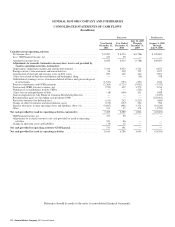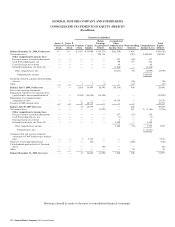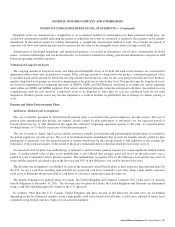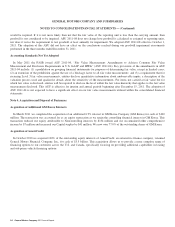General Motors 2011 Annual Report Download - page 86
Download and view the complete annual report
Please find page 86 of the 2011 General Motors annual report below. You can navigate through the pages in the report by either clicking on the pages listed below, or by using the keyword search tool below to find specific information within the annual report.GENERAL MOTORS COMPANY AND SUBSIDIARIES
NOTES TO CONSOLIDATED FINANCIAL STATEMENTS — (Continued)
annual review of our pricing service. This review includes discussion and analysis of the inputs used by the pricing service to provide
prices for the types of securities we hold. These inputs include prices for comparable securities, bid/ask quotes, interest rate yields,
and prepayment speeds. Based on our review we believe the prices received from our pricing service are a reliable representation of
exit prices.
An evaluation is made monthly to determine if unrealized losses related to non-trading investments in securities are other than
temporary. Factors considered in determining whether a loss on a marketable security is other than temporary include: (1) the length
of time and extent to which the fair value has been below cost; (2) the financial condition and near-term prospects of the issuer; and
(3) the intent to sell or likelihood to be forced to sell the security before any anticipated recovery.
Finance Receivables
Pre-Acquisition Finance Receivables
Finance receivables originated prior to the acquisition of AmeriCredit Corp. (AmeriCredit) were adjusted to fair value at October 1,
2010. As a result of the acquisition the allowance for loan losses at October 1, 2010 was eliminated and a net discount was recorded
on the receivables. The fair value of the receivables was less than the principal amount of those receivables, thus resulting in a
discount to par. This discount was attributable, in part, to future credit losses that did not exist at the origination of the receivables.
A non-accretable difference is the excess between a loan’s contractually required payments (undiscounted amount of all uncollected
principal and contractual interest payments, both past due and scheduled for the future) and the amount of the loan’s cash flows
expected to be collected. An accretable yield is the excess in the loan’s cash flows expected to be collected over the initial investment
in the loan, which at October 1, 2010 was fair value.
As a result of purchase accounting GM Financial evaluated the common risk characteristics of the loan portfolio and split it into
several pools. GM Financial’s policy is to remove a charged off loan individually from a pool based on comparing any amount
received with its contractual amount. Any difference between these amounts is absorbed by the non-accretable difference. This
removal method assumes that the amount received approximates pool performance expectations. The remaining accretable yield
balance is unaffected and any material change in remaining effective yield caused by this removal method is addressed by GM
Financial’s quarterly cash flow evaluation process for each pool. For loans that are resolved by payment in full there is no release of
the non-accretable difference for the pool because there is no difference between the amount received and the contractual amount of
the loan.
Any deterioration in the performance of the pre-acquisition receivables will result in recording an incremental provision for loan
losses. Improvements in the performance of the pre-acquisition receivables which results in a significant increase in actual or expected
cash flows will result first in the reversal of any incremental related allowance for loan losses and then in a transfer of the excess from
the non-accretable difference to accretable yield, which will be recorded as finance charge income over the remaining life of the
receivables.
Post-Acquisition Finance Receivables and Allowance for Loan Losses
Finance receivables originated after the acquisition of AmeriCredit are carried at amortized cost, net of allowance for loan losses.
Provisions for loan losses are charged to operations in amounts sufficient to maintain an allowance for loan losses at a level
considered adequate to cover probable credit losses inherent in GM Financial’s post-acquisition finance receivables.
The allowance for loan losses is established systematically based on the determination of the amount of probable credit losses
inherent in the post-acquisition finance receivables as of the balance sheet date. GM Financial reviews charge-off experience factors,
delinquency reports, historical collection rates, estimates of the value of the underlying collateral, economic trends, such as
unemployment rates, and other information in order to make the necessary judgments as to probable credit losses. GM Financial also
84 General Motors Company 2011 Annual Report
























